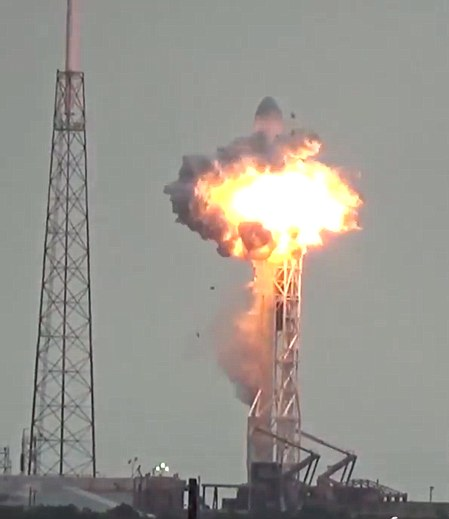Sabotage Ruled Out In September 1 Explosion of SpaceX Falcon 9
On September 1st of this year, a SpaceX Falcon 9 rocket exploded at Launch Complex 40 at Cape Canaveral. The rocket was intended to carry a one hundred and ninety five million dollar Facebook satellite into orbit to extend the reach of the Internet to unserved areas in Africa. SpaceX lost another rocket earlier this year. SpaceX has a contract with NASA to ferry astronauts to the International Space Station next year. The United Launch Alliance (ULA) has a building in Launch Complex 40 that is about a mile from the launch pad where the explosion occured. "The ULA is a joint venture of Lockheed Martin Space Systems and Boeing Defense, Space & Security. The ULA was formed in December 2006 by combining the teams at these companies which provide spacecraft launch services to the government of the United States." (Wikipedia) The ULA is a competitor of SpaceX for some government space services contracts.
In early October, rumors started circulating that the Falcon 9 rocket may have exploded due to sabotage. There was a report of a "bang" sound just before the explosion. A review of video of the explosion revealed a strange shadow and a white spot on the roof the ULA building. SpaceX requested access to the ULA roof but access was denied. Instead, the Air Force sent investigators who said that they found nothing suspicious on the roof. SpaceX has not publicly stated that they thought sabotage caused the explosion. With respect to checking the ULA roof, SpaceX said that it was just trying to cover all bases to find out what caused the explosion.
Earlier this week, SpaceX engineers revealed what they believe caused the explosion. There are three carbon fiber helium tanks inside the main fuel tank called composite overwrapped pressure vessels. Apparently, one of the helium tanks burst as it was being loaded and the helium that was released caused the oxygen that was flowing into the main tank to freeze solid. A series of explosions were triggered by the frozen oxygen.
The engineers said that they had never seen anything like this before. There was a conjunction of factors including the temperature of the liquid oxygen, the rate of flow of liquid oxygen into the main fuel tank, the behavior of the carbon-fiber in the helium tank, the rate of flow of the helium and the temperature of the helium. The engineers have been able to duplicate conditions that cause the helium tank to rupture. It will be difficult to fix the problem because of the different factors involved.
On November 4th Elon Musk, the CEO of SpaceX, appeared on the CNBC cable network and said that SpaceX had discovered the cause of the explosion of the Falcon 9. He verified what the engineers had said, that the cause of the explosion involved liquid helium, liquid oxygen and carbon-fiber materials used in the construction of the rocket. Musk said that since the problem had been identified, he was confident that SpaceX could resume rocket launches in December. SpaceX had better solve the helium loading problem quickly to remain competitive. It has already lost a ISS supply launch to another space services company called Orbital ATK.
